The Ringneck Pheasant: The Fly Tyer's Friend
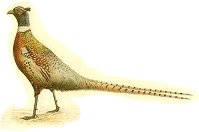
![]() There's probably not a bird that flies that has more uses
for the fly tyer than the ringneck pheasant. From the top
of its head to the tip of its tail, there's hardly a feather
on a pheasant that can't be used to some good purpose. Whether
it's hackle you need or tailing fibers, winging material or
body material, shoulders or cheeks--whatever--it's all there.
There's probably not a bird that flies that has more uses
for the fly tyer than the ringneck pheasant. From the top
of its head to the tip of its tail, there's hardly a feather
on a pheasant that can't be used to some good purpose. Whether
it's hackle you need or tailing fibers, winging material or
body material, shoulders or cheeks--whatever--it's all there.
While both the cock and the hen are extremely interesting and useful material sources for the practical and imaginative flytyer, I will consider in this article only the cock pheasant, since this is generally the more useful of the two. One cock pheasant of just average size will provide the resourceful flytyer with enough material to tie thousands of flies.
The uses for pheasant feathers described in this article are far from exhaustive, just some of the thoughts that come into my head as I sit down to write this piece. But there are enough suggestions here to at least get you started tying with this wonderful natural material, if you haven't already. At some point I intend to amplify the information in this article and publish a small book on the uses of the pheasant. In the process I hope to gather as many pheasant-based patterns from around the world (and from the past) as I can. If you have any pattern that you tie using the pheasant in some capacity and would like to be considered for inclusion in this book, please contact me your pattern (and a jpeg if possible); I'd be delighted to hear from you. Meanwhile I hope you'll enjoy--and be inspired by--this short piece.
Taking it from the top...
The Top of the Head
These mottled olive-brown feathers with a greenish cast (which interestingly enough often mirror the symmetry and coloration of the lower back feathers) can be used most effectively as hackle for soft hackle or for traditional wet flies whenever a mottled hackle is called for. They also work well as wing cases for nymphs or for the short wings on an emerging mayfly imitation.
The Iridescent Blue/Green and Back Neck Feathers
These feathers, when dipped in spar varnish and stroked to shape, make attractive and durable wings for patterns like the Letort Cricket or for beetles. The feathers can also be used to great advantage as hackle on such traditional wet fly patterns such as the Black Gnat or Butcher or on any fly where black hackle is called for. They can also be used as wing cases on nymphs and for mayfly emergers (e.g. paraleptophlebia). One of my favorite soft hackle wet flies that uses this feather is the very simple Ringneck Soft Hackle Wet Fly.
Ringneck Soft Hackle Fly
 Hook: Daiichi 1140, 1550, Mustad 3906 or similar: sizes 12 - 18
Hook: Daiichi 1140, 1550, Mustad 3906 or similar: sizes 12 - 18
Thread: 6/0 Danville's, black
Body: Thin body of olive GSS (Gartside's Secret Stuff) or natural peacock herl
Hackle: Black ringneck pheasant neck feather
The White Band (or ring) Feather
This lovely little feather can be used most obviously in tying small fan wings (e.g. the Fanwing Royal Coachman) or you can varnish, shape and color them with a yellow or green marking pen to fashion excellent leaf hopper or aphid wings.
Almond Hearts
These reddish/brown feathers are found just below the ring on both the back and breast and can be varnished and stroked to shape beautiful caddis wings for dark dry caddis patterns. One of my favorite dressings using almond hearts is the Gartside Pheasant Caddis.
Gartside Pheasant Caddis
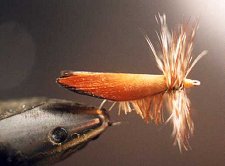 Hook: M94849, M94840, or Tiemco 100, sizes 10 - 16
Hook: M94849, M94840, or Tiemco 100, sizes 10 - 16
Thread: 6/0, brown or tan
Body: Tan or orange poly dubbing
Ribbing: Brown or tan-dyed grizzly palmered over body and then clipped (to just beneath gap of hook)
Wing: Varnished almond heart cupped over body and ribbing (wing to extend beyond hook bend)
Hackle: Brown or tan-dyed grizzly (or the two wound on together)
Church Windows
Just below the almond hearts there are larger, rather square reddish brown feathers with a cream mottled center. These feathers cover an area roughly halfway down the back and extend right and left onto each shoulder of the pheasant. I use these feathers for shoulders and cheeks on streamer patterns, as well as for wings on some streamer patterns (usually tying them matuka-style over different colored yarns or other body materials and adding a hackle collar of a deer hair head and collar). These feathers have many other uses as well for the inventive tyer.
A good example of a fly using church window feathers (as a cheek) is the Darkside, a New England-style streamer, that I first tied in 1972.
Darkside
 Hook: Mustad 9575, 3665A or any 2x or 3x streamer hook: sizes 1 - 4
Hook: Mustad 9575, 3665A or any 2x or 3x streamer hook: sizes 1 - 4
Thread: Black, 6/0
Tail: None
Body: Red floss or wool
Ribbing: Fine silver tinsel or mylar
Underwing: Four or five strands of peacock herl, under which is tied a slender bunch of fine white bucktail (both to extend beyond the bend of the hook)
Wing: Matched furnace saddle or neck feathers
Cheek: Reddish-brown church window feathers
Eyes: Jungle cock (optional)
Lower Back Feathers
These feathers have a greenish/olive to brown or red/brown cast to them, with much mottling in the center. Some pheasants (especially those raised for game farms) may have a bluish cast; these are definitely inferior to the more naturally-colored pheasants that feed in the wild.
Two of my favorite and most successful fly patterns are tied with this feather: the Gartside Pheasant Hopper and the Sparrow.
Gartside Pheasant Hopper
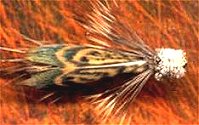 Hook: M9671, TMC 200: sizes 6 - 12
Hook: M9671, TMC 200: sizes 6 - 12
Thread: Danville's 6/0, gray or tan
Tail: Moose body hair or light elk
Body: Yellow, tan, or gray polyyarn
Ribbing: Dyed yellow, tan, or natural grizzly trimmed on bottom
Underwing: Natural deer hair (to extend to tip of tail)
Overwing: Mottled pheasant feather from the lower back area,dipped in spar varnish and stroked to shape before tying in.
Legs: Natural deer hair tied in at sides as "kickers."
Kickers should be one-half to two-thirds the length of the overwing
Head: Natural deer hair wound on and trimmed to shape (For easy deer hair method, see my book "Scratching the Surface."
Sparrow
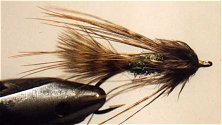
Hook: M9671, TMC 200R (or equivalent): sizes 4 - 12
Thread: 6/0 Danville's, gray or tan
Tail: Short, squarish dark brown marabou-like rump feather from area just above the legs of the pheasant. I also sometimes use similar rump feathers from a chicken (either natural brown or gray or dyed grizzly in a shade to compliment the overall color scheme of the Sparrow.
Body: Originally mixed squirrel and rabbit (two parts squirrel to one part rabbit) but now I often use polyfur of different textures as well as GSS. Body should be "rough" and not smooth. Color may vary. Good colors are Olive, Hare's Ear Red Squirrel. Brighter colors--pink, orange, chartreuse- -are also quite effective at times.
Hackle: Mottled pheasant feather from the lower back area (usually found just below the area where feathers ideal for tying the Pheasant Hopper are located). Strip away the downy base fiber from the stem; tie in at point where the stem taper becomes narrow and wind the feather on as hackle. Hackle points should extend slightly beyond the tip of the tail. Be sure to leave room for the head, which is tied in next.
Collar (or head): Aftershaft plume(s) tied in just in front of the hackle and wound around shank to form a sort of fluffy head. Thread head should be tiny and inconspicuous.
Rump feathers
These feathers are found, as you might suspect, in the rump area and are extremely useful when tying streamers, large Sparrows, as "spey" hackle, or (for those familiar with my pattern, the Stray Cat) for interesting "one-hackle" flies. These feathers are often mottled in various shades of brown with very attractive and durable barbs which can vary wildly in length from very short to very long; hence, their usefulness for many different types of flies and patterns. One of my favorite tarpon flies, the Tarpon Spey, is tied with this feather. In it I use this feather as a ribbing in much the same way salmon tyers use heron or other hackle to hackle their traditional salmon spey-style flies.
Tarpon Spey
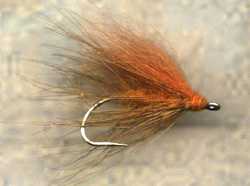 Hook: M34006, Daiichi 2546 (or similar): sizes 2/0 - 2
Hook: M34006, Daiichi 2546 (or similar): sizes 2/0 - 2
Thread: 6/0 Danville's orange
Body: Mottled orange/black or plain tan chenille
Hackle: Pheasant rump feather palmered over body (tie in at tip and wind forward so that you end up with some of the soft downy fiber up near eye)
Wing: Natural tannish raccoon hair (from tail or body) tied in so that tips extend just a little beyond bend of hook Head: Orange
Rump and or Leg-area marabou-like downy feathers
These generally brownish-red or grayish (sometimes even blackish) feathers have dozens of uses. Use them to tie very soft soft-hackle wet flies, tails for Sparrows, wing cases on mayfly nymphs, or--when long--as tails on Wooly Buggers. If long enough and wide enough you can--as I did when I first came up with the idea of the Soft Hackle Streamer--use them to tie some darker-hued Soft Hackle Streamers. If you do, use a pheasant rump hackle for the collar; it makes a most attractive streamer.
The Aftershaft
Underneath just about every body feather we've considered, you'll find another feather, a downy, usually grayish and very soft feather. This is the aftershaft feather (hypor hachis) or insulating feather. This feather is sometimes misidentified as a "philo" or "filo" feather or plume. There is such a feather as the "filoplume," but believe me this is NOT it. True filoplumes are those hair-like (filo means hair in Greek) single-strands with a tuft (or plume) on them. Filoplumes are visible only when you've plucked the skin almost bare and are of little use to the practical flytyer.
The aftershaft feather has many uses: as very soft hackle for tying soft hackle flies or traditional wet flies, as wing cases on nymphs, as bodies (when wound on) for dragonfly nymphs, or for collars on my Sparrow nymph. One of my favorite aftershaft-bodied flies is the Wet Mouse, which can also be fished as a dragonfly nymph.
The Wet Mouse
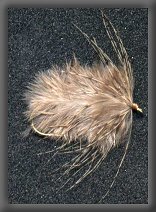 Hook: Mustad 9671 or similar: sizes 8 - 10
Hook: Mustad 9671 or similar: sizes 8 - 10
Thread: 6/0 Danville's, gray or tan
Body: Pheasant aftershaft feathers. Tie first one in just before the bend and wind forward until you've used up the feather. Tie down and trim excess. Tie in another feather just in front of the previous wound-on feather and repeat the process until the shank is covered completely with windings of aftershaft feather (leave room, however, for a collar and neat head).
Note: It's important to tie this feather in at the butt, not at the tip (which is very fragile). In fact, after tying in the feather at the butt it's wise to simply break off the tip before applying your hackle pliers (E-Z minihooks are better than pliers) and winding.
Collar Hackle: Brown mottled Partridge or other mottled soft feather
Head: Gray Read more about the Wet Mouse.
Wings (Primary and Secondary)
The wing feathers of the pheasant are useful for, among other things, tying quill wings on traditional wet flies, wing cases, tails, and legs on nymphs, and matuka-style streamers.
Tail Feathers
The tail feathers on a cock pheasant are long, thick-barbed, and barred with brown, olive and black tones. The barbs of these feathers are used largely as tailing material for nymphs and wet flies, sometimes for legs and also for bodies on small nymphs. Perhaps the most well-known fly using pheasant tail feathers is Frank Sawyer's Pheasant Tail Nymph, in which the whole nymph is constructed from wound-on pheasant tail barbs overlaid with a ribbing of gold wire.






